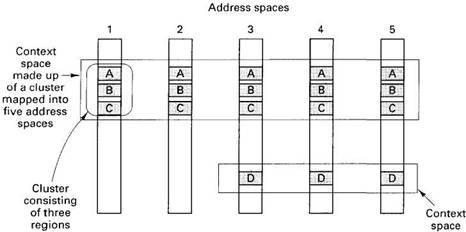Книга: Distributed operating systems
9.6.2.The COOL Base Layer
9.6.2.The COOL Base Layer
The COOL base provides a set of services for COOL user processes, specifically for the COOL generic library that is linked with each COOL process. The most important service is a memory abstraction, roughly analogous to distributed shared memory, but more tuned to object-oriented programming. This abstraction is based on the cluster, which is a set of Chorus regions backed by segments. Each cluster normally holds a group of related objects, for example, objects belonging to the same class. It is up to the upper layers of software to determine which objects go in which cluster.
A cluster can be mapped into the address spaces of multiple processes, possibly on different machines. A cluster always begins on a page boundary, and occupies the same addresses in all processes that are currently using it. The regions in a cluster need not be contiguous in virtual address space, so a cluster may, for example, occupy addresses 1024-2047, 4096-8191, and 14336-16535 (assuming a 1K page size).

Fig. 9-25. Context spaces and clusters.
A second concept supported by the COOL base is the context space, which is a collection of address spaces, again, possibly on multiple machines. Figure 9-25 shows a system with five address spaces (on up to five machines) and two context spaces. The first context space spans all the machines and contains a cluster with three regions. The threads living in these address spaces can all access the objects in this cluster as though they were in a shared memory. The second context space spans only three machines and has a cluster with one region. Threads in address spaces 1 and 2 cannot access the objects in this cluster. The corresponding clusters in different address spaces must be mapped in at the same virtual addresses. Internal pointers are relocated at the time the mapping occurs.
Clusters are not replicated. This means that although a cluster may appear in multiple address spaces at the same time, there is only one physical copy of each cluster. When a user thread tries to invoke a method on an object that is in its address space but physically not present on its machine, a trap occurs to the COOL base. The base then either forwards the request to the machine holding the cluster for remote invocation or arranges for the cluster to migrate to its machine for local invocation.
- 9.6.1. The COOL Architecture
- 9.6.4.The Language Runtime System
- Запуск InterBase-сервера
- Расширенная установка InterBase-сервера
- Резервное копирование базы данных InterBase
- Резервное копирование при работе InterBase в режиме 24x7
- Миграция между различными версиями InterBase
- Перевод базы данных InterBase 6.x на 3-й диалект
- Профилактика повреждений баз данных InterBase
- Восстановление "безнадежных" баз данных. InterBase Surgeon
- Статистика базы данных InterBase
- Информация заголовочной страницы (Database header)




